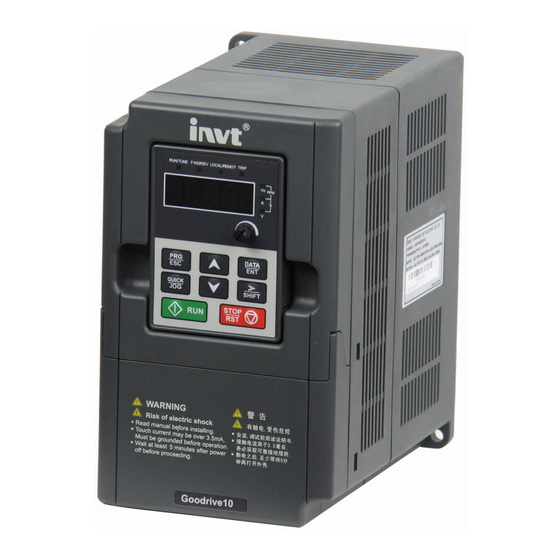
Table of Contents
Advertisement
Quick Links
Advertisement
Table of Contents

Summarization of Contents
Safety Precautions
Safety guidelines
Lists essential safety rules for operation, wiring, inspection, and component handling.
Quick Start
Unpacking inspection
Steps to check the product after receiving it.
Environment
Conditions to check before installation and usage.
Basic commission
Steps for basic commissioning before actual utilization.
Product Overview
Basic principles
Explains the fundamental operating principles, including circuit diagrams and energy feedback.
Product specification
Detailed technical specifications including input, output, and control features.
Rated specifications
Table listing rated specifications for constant and variable torque.
Installation Guidelines
Mechanical installation
Covers installation environment, direction, and manner.
Standard wiring
Provides wiring diagrams for main and control circuits.
Layout protection
Guidelines for protecting cables in short-circuit situations.
Keypad Operation Procedure
Keypad
Overview of the keypad layout, function indicators, and unit indicators.
Keypad operation
Explains how to operate the keypad and modify function codes.
Function Parameters
Function parameters
Explains the structure of function lists, parameter radix, default values, and modification.
Basic Operation Instruction
First powering on
Steps and checks for the initial powering on of the device.
Parameters of the motor
Details on setting motor parameters and performing autotune.
Start and stop control
Explains the three starting modes: direct start, DC braking start, and speed tracking start.
Frequency setting
Describes reference channels (A, B) and methods for setting frequency.
PID control
Explains PID control principles and parameter setting steps.
Fault Tracking
Alarm and fault indications
How faults and alarms are indicated by LEDs and the panel display.
Fault instruction and solution
Table detailing fault codes, types, causes, and corrective actions.
Common fault analysis
Flowcharts to diagnose and resolve common faults like motor failure or vibration.
Communication Protocol
Brief instruction to MODBUS protocol
Overview of MODBUS protocol, master-slave architecture, and transmission modes.
RTU mode
Explains the RTU communication frame format, including start/end bits and check bits.
Example of writing and reading
Demonstrates reading (03H) and writing (06H, 10H) commands with RTU and ASCII modes.
Appendix A Technical Data
Ratings
Details capacity, derating for temperature, altitude, and carrier frequency.
EMC compatibility and motor cable length
Guidelines for EMC compatibility and maximum motor cable lengths.
EMC regulations
Details EMC requirements for VFDs across different categories and environments.
Appendix B dimensional drawing
Product outline drawing and installation hole size
Provides product outline dimensions and installation hole specifications.
Appendix C Peripheral Options and Parts
C.2 Peripheral wiring
Illustrates the peripheral wiring of VFDs, including connections to keypads and reactors.
C.4 Cables
Guidelines for selecting and routing power and control cables, emphasizing shielding.
C.5 Breaker, electromagnetic contactor and leakage protection switch
Selection and usage of breakers, contactors, and leakage protection switches.
C.6 Reactors
Information on selecting input, DC, and output reactors based on VFD model and distance.
C.7 Filters
Details on input and output filters for VFDs and EMC compatibility.
C.8 Braking system
Guidance on selecting and installing braking components like resistors and units.
Appendix D Further Information
D.1 Product and service inquiries
Contact information for product and service inquiries.














Need help?
Do you have a question about the 2R2G-4 and is the answer not in the manual?
Questions and answers